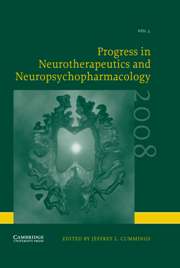No CrossRef data available.
Article contents
Clinical Trials in Dementia
Published online by Cambridge University Press: 13 June 2006
Extract
ABSTRACT
Dementia, particularly Alzheimer's disease (AD), is increasing by patient population included in clinical trials. The methodology for trials of AD patients have been defined in terms of outcomes, standard measures and analytic techniques. Trial methodology is evolving with experience as new potential therapies become available. Screening criteria, instrumentation choices, duration of trials and analytic strategies may have a profound impact on the conclusions that can be derived from trials. The components of AD trials are reviewed in detail in this chapter.
- Type
- Review Article
- Information
- Progress in Neurotherapeutics and Neuropsychopharmacology , Volume 2 , Issue 1 , March 2007 , pp. 39 - 78
- Copyright
- © 2007 Cambridge University Press




